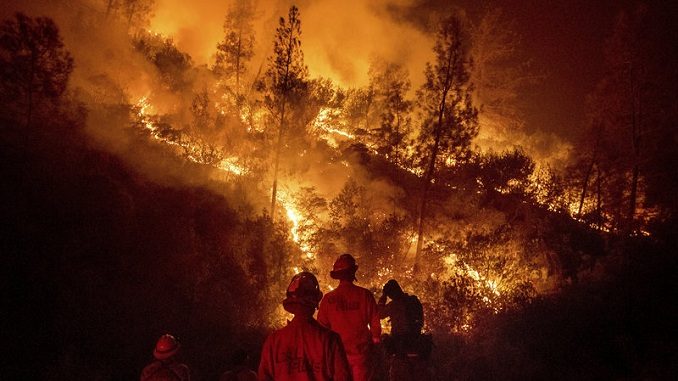
Firefighters typically make about $75,000 plus benefits for their heroic efforts each year, but a group of 3,400 wildfire-fighting inmates from the California Department of Corrections and Rehabilitation (CDCR) are risking their lives for just $2 per day and an extra $1 per hour when fighting an active fire, Newsweek reports.
“Each volunteer inmate is evaluated individually to ensure that all those selected for the camp program are willing to be team members with nonviolent behavior, even if their original conviction was for a violent crime,” CDCR representative Vicky Waters told CNBC. Volunteers must have “minimum custody” status and are not considered if they have committed arson, rape or sex offenses or if they have any active warrants or medical issues.
The inmate volunteers live in “conservation camps” and do physical labor like cutting brush and trees to reduce fire danger, clearing flood channels and storm drains and maintaining hiking trails. The program dates back to 1915, when the CDCR first established labor camps that forced inmates to build highways and roads. Today, the CDCR, CAL FIRE and the Los Angeles County Fire Department jointly operate 43 adult conservation camps in 27 counties, with about 3,400 inmates participating in total.
Many have criticized programs like these for putting inmates in harm’s way – and just like full-time civilian firefighters, inmate firefighters face serious risk when performing tasks like creating containment lines.
“It’s a cruel joke. You’re volunteering to put your life on the line, but you’re not really volunteering—the system evolved out of a system of slavery where we commodify human bodies and function off of their labor,” said Deirdre Wilson, a former inmate who served in the Puerta La Cruz fire camp between 2004 and 2005.
Wilson, who is currently the program coordinator for Project Rebound at California State University, Fullerton, said she signed up for the fire program because she saw it as a way to reduce her sentence and was desperate to return to her children.
“The camps were much nicer than regular prison, there are better facilities and you’re not locked in a room. It was a lot more freedom and we ate much better,” Wilson says. Initially, Wilson was sentenced to seven years for her involvement with a Marin County “family cult” that was connected to the starvation death of a 19-month-old boy, but was released after three years and seven months.
While inmates are proud of their work there and grateful for a break from the confinement of most prisons, “the whole situation is a massive power dynamic which doesn’t mix with safety,” she explained. “People don’t want to go back to regular prison so they might not disclose when they have an injury or when a captain is being abusive,” she adds.
Since the Mendocino Complex Fire began on July 27th, nearly 350,000 acres of northern California have been scorched, making the blaze the largest fire in the state’s history, and as of Monday, 146 homes have been destroyed and more than 1,000 buildings remain in peril.

Be the first to comment